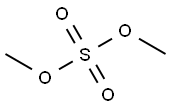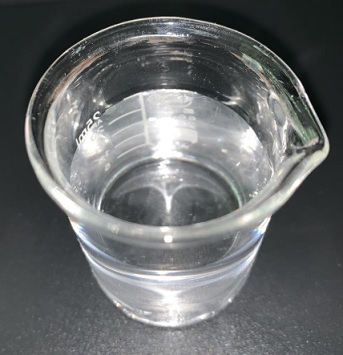General Description
DIMETHYL SULFATE(77-78-1) is a colorless oily liquid, odorless to a faint onion-like odor. DIMETHYL SULFATE(77-78-1) is very toxic by inhalation. DIMETHYL SULFATE(77-78-1) is a combustible liquid and has a flash point of 182°F. DIMETHYL SULFATE(77-78-1) is slightly soluble in water and decomposed by water to give sulfuric acid with evolution of heat. DIMETHYL SULFATE(77-78-1) is corrosive to metals and tissue.
Reactivity Profile
Pure DIMETHYL SULFATE and concentrated aqueous ammonia react extremely violently with one another, as is the case for tertiary organic bases, [NFPA 491M, 1991]. Dimethyl sulfate ignites in contact with unheated barium chlorite, due to the rapid formation of unstable methyl chlorite. The product of methylating an unnamed material at 110°C was alloyed to remain in a reactor for 80 min. before the reactor exploded. This involved a sulfur ester such as dimethyl sulfate, [MCA Case History No. 1786].
Air & Water Reactions
Water soluble.
Health Hazard
Acute: extremely toxic vapors and liquid--a few whiffs or contact on skin could be fatal. Also acutely toxic if ingested. Delayed effects which are ultimately fatal may also occur. Lethal concentrations as low as 97 ppm/10 min have been reported in humans. DNA inhibition and damage to human somatic cells, and sister chromatid exchange in human fibroblast cells were observed. Delayed appearance of symptoms may permit unnoticed exposure to lethal quantities.
Fire Hazard
Material is normally stable even under fire exposure conditions and is not hazardously reactive with water. DIMETHYL SULFATE is incompatible with strong oxidizers and strong ammonia solutions.
Application
Dimethyl Sulfate is a diester of methanol and sulfuric acid. Dimethyl Sulfate is commonly used as a reagent for the methylation of phenols, amines, and thiols. Dimethyl Sulfate is an effective and widely used probe for sequence-specific protein-DNA interactions.
Definition
ChEBI: The dimethyl ester of sulfuric acid.
Preparation
Dimethyl sulfate is prepared by distillation of an oleum/methanol mixture; technical production using dimethyl ether and SO3 has also been reported (NLM, 2013).
Flammability and Explosibility
Dimethyl sulfate is a combustible liquid (NFPA rating = 2). Toxic dimethyl sulfate vapors are produced in a fire. Carbon dioxide or dry chemical extinguishers should be used to fight dimethyl sulfate fires.
Chemical Reactivity
Reactivity with Water Slow, non-hazardous reaction; Reactivity with Common Materials: Corrodes metal when wet; Stability During Transport: Stable; Neutralizing Agents for Acids and Caustics: Sodium bicarbonate or lime; Polymerization: Not pertinent; Inhibitor of Polymerization: Not pertinent.
Potential Exposure
Tumorigen,Mutagen; Reproductive Effector; Human Data; PrimaryIrritant. Industrial use of dimethyl sulfate is based upon itsmethylating properties. It is used as an alkylating agent; inthe manufacture of methyl esters, ethers, and amines; indyes, drugs, perfume, phenol derivatives, and other organicchemicals; as a solvent in the separation of mineral oils; asan intermediate in the manufacture of sodium acetylide synthesis, as well as many pharmaceuticals and pesticides.
First aid
If this chemical gets into the eyes, remove anycontact lenses at once and irrigate immediately for at least30 min, occasionally lifting upper and lower lids. Seek medical attention immediately. If this chemical contacts theskin, remove contaminated clothing and wash immediatelywith soap and water. Seek medical attention immediately. Ifthis chemical has been inhaled, remove from exposure,begin rescue breathing (using universal precautions, including resuscitation mask) if breathing has stopped and CPR ifheart action has stopped. Transfer promptly to a medicalfacility. When this chemical has been swallowed, get medical attention. If victim is conscious, administer water ormilk. Do not induce vomiting. Medical observation isrecommended for 2448 h after breathing overexposure, aspulmonary edema may be delayed. As first aid for pulmonary edema, a doctor or authorized paramedic may consideradministering a corticosteroid spray.
Carcinogenicity
Dimethyl sulfate is reasonably anticipated to be a human carcinogenbased on sufficient evidence of carcinogenicity from studies in experimental animals.
Environmental Fate
Chemical/Physical. Hydrolyzes in water (half-life = 1.2 h) to methanol and sulfuric acid
(Robertson and Sugamori, 1966) via the intermediate methyl sulfuric acid (Du Pont, 1999a)
storage
work with dimethyl sulfate should be conducted in a fume hood to prevent exposure by inhalation, and appropriate impermeable gloves and safety goggles should be worn at all times to prevent skin and eye contact.
Shipping
This compound requires a shipping label of“POISONOUS/TOXIC MATERIALS, CORROSIVE.” Itfalls in Hazard Class 6.1 and Packing Group I.
Incompatibilities
Dimethyl sulfate can react violently with ammonium hydroxide, sodium azide, and strong oxidizers.
Waste Disposal
Excess dimethyl sulfate and waste material containing this substance should be placed in a covered metal container, clearly labeled, and handled according to your institution's waste disposal guidelines.

